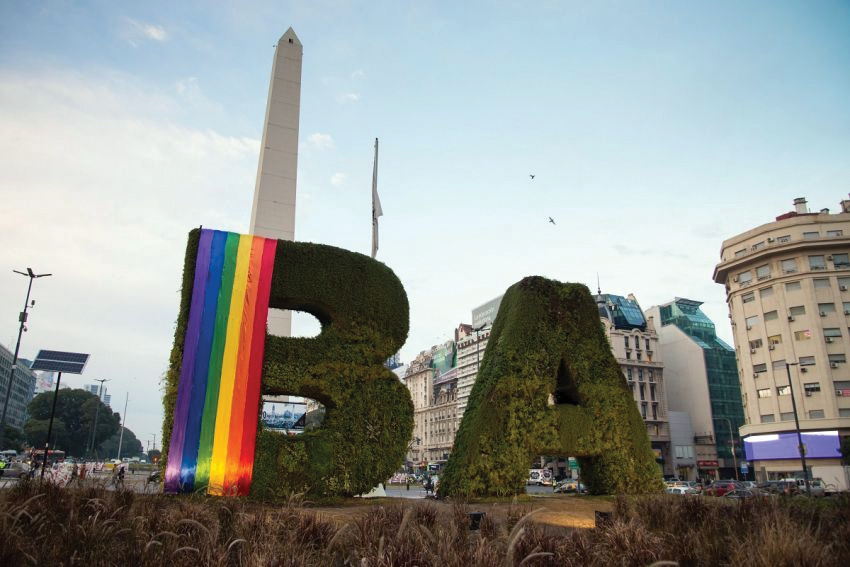Buenos Aires es la capital y ciudad más poblada de la Argentina. Esta es una ciudad autónoma que constituye uno de los 24 distritos que conforman el país. Tiene sus propios poderes ejecutivo, legislativo y judicial. Está situada en la región centro-este del país, sobre la orilla sur del Río de la Plata.
Los resultados definitivos del censo de 2010 contabilizaron la población de la ciudad en 2.890,151 habitantes junto a ciertos partidos-municipios de la lindera Provincia de Buenos Aires en el último conteo no oficial se estima que 17.200,000 habitantes (2018),esta cifra la coloca como una de las metrópolis de Sudamérica de Hispanoamérica, del hemisferio sur entre las 20 mayores ciudades del mundo.
Buenos Aires es una ciudad cosmopolita y un importante destino turístico. Su compleja infraestructura la convierte en una de las metrópolis de mayor importancia en América y es una ciudad global de categoría alfa, dadas sus influencias en el comercio, finanzas, moda, arte, gastronomía, educación, entretenimiento y principalmente en su marcada cultura. Según un estudio de calidad de vida en el año 2016, de Mercer Human Resource Consulting la ciudad se encuentra en la posición 93 a nivel mundial y segunda de América Latina tras Montevideo.
Su perfil urbano es marcadamente ecléctico. Se mezclan los estilos colonial español, art decó, neogótico, italianizante, francés borbónico. Por esto último sumado a su desarrollo edilicio y marcada influencia europea en su arquitectura en determinadas zonas, es que se la conoce en el mundo por el apodo de La París de América.
En la llamada primera fundación, Pedro de Mendoza llamó al lugar Real de Nuestra Señora Santa María del Buen Ayre, para cumplir la promesa que hiciera a la Patrona de los Navegantes, que se hallaba en la Cofradía de los Mareantes de Triana y de la que él era miembro. En efecto, (Buen Ayre), la castellanización del nombre de la Virgen de Bonaria, es decir de la Virgen de la Candelaria, a quien los padres mercedarios habían levantado un santuario para los navegantes en Cagliari, Cerdeña, y que era venerada también por los navegantes de Cádiz, España. Mendoza no fundó una ciudad, sino que estableció un simple asentamiento.
Por muchos años se le atribuyó el nombre a Sancho del Campo, de quien Ruy Díaz de Guzmán en su obra La Argentina manuscrita recogió la frase: Qué buenos aires son los de este suelo!, que pronunció al bajar. Sin embargo, en 1892, Eduardo Madero, tras realizar exhaustivas investigaciones en los archivos españoles, terminaría por concluir que el nombre estaba íntimamente relacionado con la devoción de los marinos sevillanos por Nuestra Señora de los Buenos Aires. El autor Pastor S. Obligado atribuía el homenaje a la Virgen del Buen Aire a Leonardo Gribeo, escudero de Mendoza.
Con la llamada segunda fundación se fundó oficialmente la ciudad, recibiendo de su fundador Juan de Garay el nombre de Ciudad de la Trinidad, que fue el nombre oficial de la ciudad hasta 1996. La razón sería que la festividad más importante cercana a la fecha había sido la de la Trinidad o, según algunos historiadores, porque la nave ancló el día de dicha festividad. Pero al puerto le dio el nombre de Puerto de Santa María de los Buenos Ayres. Sin embargo, los designios del burgalés no tuvieron éxito, ya que, a pesar de que jamás hubo disposición oficial alguna que cambiara su nombre, el uso inapelablemente consagró desde el primer momento el nombre de Buenos Aires para la ciudad.
En Argentina, suelen referirse a ella con distintas denominaciones. El nombre de Capital Federal es uno de los más utilizados sobre todo para diferenciarla de la provincia homónima, en alusión a la condición de distrito independiente que adquirió con la ley de federalización que promulgara Julio Argentino Roca. Muchas veces también se usa la expresión (Ciudad de Buenos Aires, o sencillamente (Buenos Aires), aunque esta última se presta a confusión con la provincia lindante, de la que fue su capital hasta 1880, año en que fue federalizada.
Ciudad de Buenos Aires y Ciudad Autónoma de Buenos Aires son las dos denominaciones que oficialmente le dio la Constitución de la ciudad sancionada en 1996. Es por esto que también suele emplearse la abreviatura ‘CABA’ para mencionarla. Informalmente suele llamársela Baires, apócope de la forma original, común dentro de la ciudad pero poco utilizada en el interior del país. Poéticamente se le han atribuido numerosos nombres, tales como la París del sur, por su belleza arquitectónica y su carácter cultural; o la Cabeza de Goliat, según un ensayo de Ezequiel Martínez Estrada, en alusión a su tamaño e influencia desproporcionada sobre el resto del país; o la Reina del Plata, como la denominan Manuel Jovés y Manuel Romero en un famoso tango, tomando una metáfora que ya había utilizado Esteban Echeverría en su poema Avellaneda; o La ciudad de la furia, término empleado por la banda argentina de rock Soda Stereo, para describir en su tema homónimo a Buenos Aires.

Buenos Aires is the capital and most populous city of Argentina. This is an autonomous city that constitutes one of the 24 districts that make up the country. It has its own executive, legislative and judicial powers. It is located in the central-eastern region of the country, on the southern shore of the Río de la Plata.
The final results of the 2010 census accounted for the population of the city at 2 890 151 inhabitants together with certain parties-municipalities of the border of the Province of Buenos Aires in the last unofficial count, an estimated 17 200 000 inhabitants (2018), this figure it places it as one of the metropolises of South America of Latin America, of the southern hemisphere among the 20 largest cities in the world.
Buenos Aires is a cosmopolitan city and an important tourist destination. Its complex infrastructure makes it one of the most important metropolises in America and is a global city of alpha category, given its influences on trade, finance, fashion, art, gastronomy, education, entertainment and mainly in its marked culture. According to a study of quality of life in 2016, Mercer Human Resource Consulting the city is in the 93rd position in the world and second in Latin America after Montevideo.
Its urban profile is markedly eclectic. The Spanish colonial, art deco, neo-Gothic, Italianizing, Bourbon French styles are mixed. Due to the latter added to its building development and strong European influence in its architecture in certain areas, it is known in the world by the nickname of The Paris of America.
In the so-called first foundation, Pedro de Mendoza called the Royal place of Our Lady Santa María del Buen Ayre, to fulfill the promise he made to the Patroness of the Navigators, who was in the Brotherhood of the Dizziness of Triana and from which He was a member. Indeed, (Buen Ayre), the Castilianization of the name of the Virgin of Bonaria, that is to say of the Virgin of the Candelaria, to whom the mercedarian fathers had built a sanctuary for sailors in Cagliari, Sardinia, and which was also venerated by the navigators of Cádiz, Spain. Mendoza did not found a city, but established a simple settlement.
For many years the name was attributed to Sancho del Campo, from whom Ruy Díaz de Guzmán in his work Handwritten Argentina picked up the phrase: What good airs are those of this soil!, Which he pronounced when he went down. However, in 1892, Eduardo Madero, after thorough research in the Spanish archives, would conclude that the name was closely related to the devotion of the Sevillian sailors for Our Lady of the Buenos Aires. The author Pastor S. Obligado attributed the tribute to the Virgin of Good Air to Leonardo Gribeo, squire of Mendoza.
With the so-called second foundation the city was officially founded, receiving from its founder Juan de Garay the name of the City of the Trinity, which was the official name of the city until 1996. The reason would be that the most important holiday near to date had been that of the Trinity or, according to some historians, because the ship anchored the day of the festival. But to the port he gave the name of Puerto de Santa María de los Buenos Ayres. However, the designs of the Burgos were unsuccessful, since, although there was never any official provision that changed its name, the use unavoidably enshrined from the outset the name of Buenos Aires for the city.
In Argentina, they usually refer to it with different denominations. The name of Federal Capital is one of the most commonly used to differentiate it from the homonymous province, in reference to the status of an independent district that it acquired with the federalization law promulgated by Julio Argentino Roca. Many times the expression is also used (City of Buenos Aires, or simply (Buenos Aires), although the latter lends itself to confusion with the bordering province, of which it was its capital until 1880, year in which it was federalized.
The City of Buenos Aires and the Autonomous City of Buenos Aires are the two denominations officially given by the Constitution of the city sanctioned in 1996. This is why the abbreviation ‘CABA’ is also used to mention it. Informally, it is usually called Baires, an apocope of the original form, common within the city but rarely used in the interior of the country. Poetically they have been attributed numerous names, such as southern Paris, for its architectural beauty and cultural character; or the Head of Goliath, according to an essay by Ezequiel Martínez Estrada, in reference to its size and disproportionate influence on the rest of the country; or the Queen of Silver, as Manuel Jovés and Manuel Romero call it in a famous tango, taking a metaphor that Esteban Echeverría had already used in his poem Avellaneda; o The city of fury, a term used by the Argentine rock band Soda Stereo, to describe in its homonymous theme to Buenos Aires.














